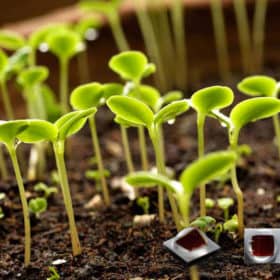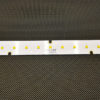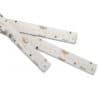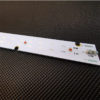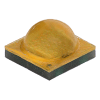Grow Room Setup
Does Side Lighting Plants make a Difference
Nature remains the teacher of all things in the natural world. The sun rises low across the horizon, produces light from the vertical at noon, and completes the arc to set once more on the horizon. Cannabis along with many species naturally shaped and formed its growth and structure to better collect light this way. The plant evolved in a triangular shape to present itself to the way beams of light fall.
Enhancing Horticultural Growth: The Role of Side Lighting
Introduction: The world of horticulture continually seeks innovative ways to optimize plant growth and yield. Among the various techniques employed, side lighting in indoor growing environments, particularly for cannabis cultivation, has garnered attention for its unique benefits and certain drawbacks.
Understanding Side Lighting: Side lighting refers to the placement of light sources on the sides of plants rather than above. This method aims to provide more uniform light exposure, especially for taller or bushier plants where top lighting might not suffice. Side lighting is often used alongside traditional overhead lighting to promote even growth and robust development of lower plant sections. In cannabis cultivation, side lighting helps mimic the natural sunlight progression, encouraging a more natural growth pattern and improved bud development.
Benefits of Side Lighting:
- Enhanced Light Penetration and Distribution: Side lighting ensures that lower parts of the plant, which might otherwise be shaded, receive adequate light. This leads to better overall light distribution and improved photosynthesis in lower leaves.
Enhanced Light Distribution
- Improved Canopy Penetration: Lateral lighting can reach areas of the plant that top lighting often misses, especially in dense canopies. This increased penetration helps lower leaves and branches receive adequate light, crucial for photosynthesis.
- Uniform Growth: By providing light from the sides, plants can grow more uniformly. This is particularly important for tall or bushy plants where the upper leaves might shade the lower parts, leading to uneven growth.
- Reduction in Phototropism: Plants naturally grow towards the light source (phototropism). Lateral lighting can reduce this effect, leading to straighter growth rather than leaning towards the top light source.
Impact on Photosynthesis
- Increased Photosynthetic Efficiency: Lateral lighting ensures that more leaves have access to light, potentially increasing the overall photosynthetic efficiency of the plant.
- Enhanced Growth Rates: With more leaves involved in photosynthesis, plants can experience enhanced growth rates and potentially increased yield.
Morphological Changes
- Compact Growth: Side lighting can promote more compact and bushier growth, as the lower branches receive sufficient light to develop fully.
- Improved Flowering and Fruiting: In flowering plants, adequate light on lower branches can lead to more flowering sites and potentially better fruiting, if applicable.
Energy Utilization
- Optimized Energy Use: Lateral lighting can be more energy-efficient in certain setups. By targeting light directly where it’s needed, growers might be able to use lower-intensity lights or run lights for shorter periods.
Crop-Specific Responses
- Varied Responses Based on Species: Different plant species and even different strains within a species may respond uniquely to lateral lighting. Some may show significant improvements in growth and yield, while others may exhibit minimal changes.
- Tailored Lighting Strategies: Depending on the crop’s specific light requirements, lateral lighting strategies can be tailored for maximum effectiveness, such as adjusting the light spectrum or intensity.
Potential Challenges
- Heat Stress: Depending on the type of lights used, side lighting can add extra heat to the growing environment, which needs to be managed to avoid plant stress.
- Shading Issues: In some setups, the physical presence of lateral lights might create shading, affecting the distribution of light from other sources.
- Complexity in Setup: Implementing an effective lateral lighting system requires careful planning and can add complexity to the grow operation, particularly in terms of ensuring uniform light distribution.
- Increased Yields: By ensuring more uniform light exposure, side lighting can lead to an increase in yield, particularly in the lower sections of the plant.
Principle Behind Increased Yields
- Uniform Light Exposure: Side lighting provides a more even distribution of light to all parts of the plant, not just the top canopy. This uniform exposure is crucial for the lower sections of the plant, which often receive less light in traditional top lighting setups.
- Photosynthetic Enhancement: By illuminating the lower and inner parts of the plant, side lighting enhances photosynthesis throughout the entire plant structure. Enhanced photosynthesis directly contributes to healthier plant growth and increased biomass.
- Reduced Shading Effect: In dense plantings, the upper leaves and branches can shade the lower parts of the plant. Side lighting reduces this shading effect, allowing lower leaves to contribute more significantly to the plant’s overall growth.
Direct Impact on Yield
- Increased Flowering Sites: In flowering plants, including many types of vegetables and ornamentals, side lighting can lead to an increase in the number of flowering sites. This increase can directly translate into a higher yield of flowers and fruits.
- Enhanced Bud Development: For crops like cannabis, where the value lies in the buds, side lighting ensures that lower buds develop more fully, leading to a higher overall yield.
- Better Fruit Size and Quality: In fruit-bearing plants, improved light penetration can result in better fruit development, size, and quality, particularly in fruits that develop lower on the plant.
Case Studies and Examples
- Vertical Farming Successes: In vertical farming setups, where plants are grown in stacked layers, side lighting has been particularly effective in increasing yield per square foot, as every part of the plant receives adequate light.
- Cannabis Cultivation: Research and anecdotal evidence from cannabis cultivation have shown that side lighting can significantly increase yield, especially in the lower branches, which traditionally produce smaller, less potent buds.
- Greenhouse Applications: In greenhouses, the use of side lighting alongside top lighting has been shown to boost yields during the darker months, compensating for the reduced natural sunlight.
Considerations for Maximizing Yields
- Light Intensity and Spectrum: The effectiveness of side lighting in increasing yields also depends on the intensity and spectrum of the light used. Tailoring these factors to the specific needs of the crop can optimize the yield increase.
- Plant Density and Arrangement: Optimizing plant spacing and arrangement to take full advantage of side lighting can further enhance yield.
- Integration with Other Cultivation Practices: Combining side lighting with other cultivation practices, such as pruning, training, and optimal nutrient management, can synergistically increase yields.
- Improved Plant Health: Adequate light exposure to all parts of the plant supports healthier growth, better nutrient processing, and can enhance resistance to pests and diseases.
Enhanced Photosynthesis and Growth
- Balanced Photosynthesis: Side lighting ensures that light reaches more of the plant’s surface area, allowing for balanced photosynthesis throughout the plant. This comprehensive exposure is crucial for the overall health and vigor of the plant.
- Stronger Plant Structure: With uniform light distribution, plants develop a stronger and more balanced structure. This is because lower branches and leaves receive sufficient light, contributing to the overall stability and robustness of the plant.
Better Nutrient Processing
- Efficient Nutrient Utilization: Adequate light is essential for plants to process and utilize nutrients effectively. With improved light exposure from side lighting, plants can make better use of the nutrients available to them, leading to healthier growth.
- Enhanced Metabolic Activities: Uniform light exposure boosts the plant’s metabolic activities, including photosynthesis and respiration, leading to more vigorous growth and development.
Disease and Pest Resistance
- Reduced Fungal Growth: Plants that are weak or shaded are more susceptible to fungal infections. Uniform light exposure reduces damp, shaded areas where fungi typically thrive.
- Stronger Immune Response: Healthy, well-lit plants often have a stronger natural defense against pests and diseases. Adequate light exposure helps plants produce essential oils and other compounds that can deter pests and pathogens.
- Less Stress-Induced Vulnerability: Plants under stress are more vulnerable to diseases and pest infestations. Consistent and adequate lighting reduces plant stress, thereby enhancing their resilience.
Improved Overall Health and Quality
- Uniform Coloration and Growth: Plants receiving even light exposure tend to have uniform coloration and growth, which is a sign of good health.
- Optimal Growth Conditions: Side lighting creates an environment where all parts of the plant can grow optimally, resulting in healthier and more aesthetically pleasing plants.
- Longer Lifespan: Plants that grow in optimal conditions with adequate lighting often have a longer lifespan and remain productive for a more extended period.
Considerations for Optimal Health
- Customized Lighting Strategies: Tailoring the lighting strategy to the specific plant species can further enhance plant health. Different plants have varying light requirements for optimal growth.
- Monitoring and Adjustments: Regular monitoring and adjustments to the lighting setup may be necessary to ensure that all plants receive optimal light exposure, particularly in densely planted areas.
- Integration with Other Environmental Controls: Combining side lighting with appropriate environmental controls (temperature, humidity, CO2 levels) ensures that plants grow in the most conducive conditions.
- Adaptability: Side lighting can be effectively used in various indoor setups, including compact growing spaces and large-scale facilities.
Versatility in Different Growing Environments
- Compact Growing Spaces: Side lighting is particularly beneficial in small, confined areas such as indoor grow tents or home growing setups. In these environments, plants may not have enough room to spread out, resulting in inadequate light reaching the lower foliage. Side lighting can effectively address this issue, providing vital illumination to the lower parts of the plants.
- Large-Scale Facilities: In commercial or large-scale horticultural operations, uniform light distribution becomes challenging with just top lighting, especially for tall or densely planted crops. Side lighting in these facilities ensures that all areas of the plant receive adequate light, which is crucial for maintaining consistent growth and quality across the entire crop.
Application in Vertical Farming
- Maximizing Space Utilization: Vertical farming, where plants are stacked in layers, greatly benefits from side lighting. It allows for maximum utilization of vertical space without compromising on light distribution to each plant.
- Enhanced Light Penetration: In vertical systems, side lighting can penetrate foliage more effectively than top lighting, ensuring that even the plants in the middle of a stack receive sufficient light.
Integration with Existing Lighting Systems
- Supplemental Lighting: Side lighting can be integrated with existing overhead lighting systems to supplement areas where light penetration is insufficient. This dual approach can optimize light exposure for all parts of the plant.
- Flexibility in Installation: Side lighting fixtures come in various forms, like LED strips or tubular lights, offering flexibility in installation. They can be easily mounted at different heights and positions to suit the specific layout of a growing area.
Customizable for Specific Plant Needs
- Adjustable Intensity and Spectrum: Modern side lighting systems, especially those using LEDs, can be adjusted in terms of light intensity and spectrum. This feature allows growers to tailor the lighting to the specific needs of different plant species or growth stages.
- Directional Lighting: Side lighting provides directional light, which can be strategically positioned to target specific areas of the plant. This targeted approach is especially useful for plants that have specific light requirements for optimal growth.
Enhanced Aesthetic and Practical Benefits
- Improved Working Environment: In large-scale operations, side lighting can provide better visibility for workers, making plant care and maintenance easier and more efficient.
- Aesthetic Display: For retail environments or public displays, side lighting can enhance the aesthetic appeal of plants, highlighting their features and improving the overall display quality.
Drawbacks of Side Lighting:
- Higher Initial and Running Costs: Implementing side lighting involves additional expenses for equipment and increased energy consumption.
Higher Initial Costs
- Equipment Purchase: The initial setup of side lighting systems requires purchasing additional lighting fixtures. Depending on the type of lights chosen (e.g., LED, CFL), this can be a significant investment. Advanced lighting systems, especially those designed for optimal spectrum output and energy efficiency, tend to be more expensive.
- Installation Costs: Setting up side lighting may require professional installation, especially in larger or more complex growing setups. This includes the cost of labor, wiring, and additional infrastructure needed to support the extra lighting.
- Integration with Existing Systems: Integrating side lighting with existing overhead lighting systems might require additional controllers or adjustments to the current setup, adding to the initial cost.
Higher Running Costs
- Increased Energy Consumption: Side lighting increases the total amount of lighting, which in turn raises energy consumption. This leads to higher electricity bills, which is a crucial factor to consider, especially in large-scale operations.
- Maintenance and Replacement: Additional lighting fixtures mean more components that may need maintenance or replacement over time. The lifespan of bulbs, especially in high-intensity lighting setups, can add to ongoing costs.
- Heat Management: Extra lighting can generate more heat, necessitating enhanced cooling or ventilation systems to maintain optimal growing conditions. This can involve additional energy costs and potential upgrades to the existing climate control systems.
Considerations for Budgeting
- Energy-Efficient Options: Opting for energy-efficient lighting such as LEDs can help mitigate running costs over time, despite higher initial expenses.
- Scalability: For growers considering expanding their operation, the scalability of the lighting system should be considered. A system that can easily be scaled up or down can be more cost-effective in the long run.
- Cost-Benefit Analysis: Conducting a thorough cost-benefit analysis can help determine the return on investment. While initial and running costs are higher, the potential increase in yield and quality might justify the expense for some growers.
- Heat Management: Additional lighting can raise the temperature of the growing environment, necessitating effective heat management strategies.
The Challenge of Heat Generation
- Heat Emission from Lighting: Additional lighting, including side lighting, can generate heat. This is particularly true for certain types of grow lights, such as high-intensity discharge (HID) lamps. Even though LEDs are more efficient and generate less heat than other types, the cumulative heat from multiple light sources can still impact the growing environment.
- Impact on Plant Growth: Excessive heat can negatively affect plant growth. It can lead to issues like heat stress, dehydration, and even burning of plant tissues. Managing the heat is crucial to maintain an optimal growing environment.
Strategies for Heat Management
- Ventilation Systems: Effective ventilation is key in dispersing heat. Installing fans or enhancing the existing air circulation can help in maintaining a stable temperature. The placement of fans should be strategic to ensure even distribution of air and avoid hotspots.
- Climate Control Systems: Advanced climate control systems can automatically adjust temperature and humidity levels. These systems can be integrated with the lighting setup to react dynamically to changes in heat levels.
- Heat Sinks and Cooling Equipment: For LED lighting systems, heat sinks are used to dissipate heat away from the light source. In more intensive setups, additional cooling equipment like air conditioners or chillers might be necessary.
- Regular Monitoring: Regularly monitoring the temperature and humidity levels helps in identifying and addressing heat issues promptly. Digital thermometers and humidity sensors can provide accurate readings and can often be integrated into centralized control systems.
- Spatial Arrangement of Lights: Proper spacing between the lights and the plants can reduce the risk of heat stress. Adjusting the height and position of side lights according to the plant’s growth stage can help manage heat exposure.
- Use of Reflective Materials: Installing reflective materials on walls and surfaces can help in directing light more efficiently towards plants, reducing the need for excessive lighting and thereby reducing heat.
Considerations for Different Setups
- Small-Scale Grows: In smaller setups like home grow tents, careful placement of fans and regular manual monitoring can effectively manage heat. LED lights are preferable due to their lower heat output.
- Large-Scale Operations: In commercial facilities, automated climate control systems are more practical. These systems can adjust temperature and humidity levels in response to the heat generated by the lighting.
- Vertical Farms: In vertical farming setups, the close proximity of plants and lights necessitates careful heat management. LEDs with built-in cooling systems or external heat sinks can be particularly beneficial.
- Risk of Light Burn: Overexposure or incorrect placement of side lights can lead to light burn, potentially damaging the plants.
Understanding Light Burn
- Cause and Effect: Light burn occurs when plants are exposed to too much light intensity or when light sources are placed too close to the plants. This excessive exposure can damage the leaves and buds, leading to discoloration, bleaching, and ultimately, a reduction in plant health and productivity.
- Symptoms in Plants: Signs of light burn in plants include yellowing or browning of the leaves, especially at the tips and margins. In severe cases, leaves may become crispy and curled. Unlike nutrient burn, which typically starts at the tips of the leaves, light burn can affect the areas of the leaf most directly exposed to the light source.
Risks Associated with Side Lighting
- Intensity of Side Lights: Side lighting, when too intense or placed too close to the plants, can lead to overexposure. Plants that are not accustomed to intense lateral light may be particularly susceptible to light burn.
- Incorrect Placement: Improper placement or angling of side lights can concentrate light on certain areas of the plant, increasing the risk of light burn. This is especially a concern for taller plants where the upper sections may be too close to the side lights.
- Variability in Plant Tolerance: Different plant species and even different strains within a species have varying tolerance levels to light intensity. Some plants may be more prone to light burn under conditions that others can tolerate well.
Preventing Light Burn
- Proper Light Positioning: Adjust the height and angle of side lights to ensure that they are not too close to the plant canopy. The optimal distance may vary based on the light type and the plant species.
- Gradual Light Introduction: Gradually acclimate plants to side lighting, especially if they have been grown under less intense light conditions. Incrementally increasing the light intensity or duration can help plants adjust without stress.
- Monitoring Light Intensity: Using a light meter can help in monitoring and adjusting the intensity of side lights to stay within a safe range for the plants.
- Observation and Adjustment: Regularly inspect plants for signs of light burn. If symptoms are observed, adjust the lighting immediately, either by reducing intensity, increasing distance, or changing the duration of exposure.
- Using Diffusers or Filters: In some cases, light diffusers or filters can be used to reduce the intensity of the light reaching the plant, thereby mitigating the risk of light burn.
- Complexity: Setting up and optimally positioning side lights requires careful planning and can add complexity to the growing setup.
Conclusion: Side lighting in horticulture, particularly for indoor cannabis cultivation, offers significant advantages in improving light distribution, plant health, and yield. However, these benefits come with considerations around cost, heat management, and setup complexity. Growers should assess their specific needs, space limitations, and resources to determine if side lighting is a suitable addition to their cultivation strategy.


